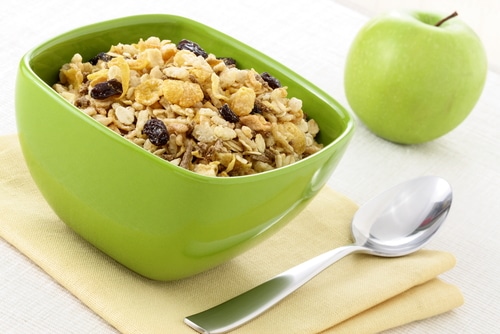
Fiber Slows Down Stomach Emptying
When you eat a high-fiber meal, you’ll stay fuller longer. That’s because fiber traps water when it enters the stomach. This increases the volume of material in the stomach causing it to “stretch.” This stretching slows down the rate at which your stomach empties. That means you’ll consume less food at a meal because you’ll get full more quickly and stay fuller longer.
Dietary Fiber Reduces Fat Absorption
Who doesn’t want free calories? Dietary fiber is a natural fat blocker. When you eat fat along with a high-fiber meal, some of that calorie-rich fat is excreted without being absorbed, so it doesn’t end up on your waistline. The amount of fat you lose is only in the range of 3 to 5%, but it adds up if you eat a fiber-rich diet consistently.
Fiber Increases Insulin Sensitivity
According to research published in Diabetes Care, fiber boosts insulin sensitivity. This means you need less of it to ferry glucose into cells. Less insulin can work in your favor when it comes to weight control since insulin is a hormone that promotes fat storage. A high-fiber diet also reduces the risk of type 2 diabetes because it helps insulin work better.
How Much Fiber Do You Need?
Shoot for 25 grams of fiber a day if you’re female and 38 grams if you’re a male. Sadly, most people get less than 15 grams of fiber a day. Some of the best sources of dietary fiber are whole grain foods, oat bran, rice bran, barley, beans, fruits, and vegetables. Begin the day with a bowl of oatmeal with nuts and berries or a serving of bran cereal, and you’ll get a jump start on your daily fiber requirement.
Replace starchy side dishes with servings of beans and vegetables to boost fiber intake even more, and substitute processed grains with whole grains that haven’t been stripped of their fiber. Begin a meal with a crunchy salad that has a colorful array of raw vegetables. You’ll get the additional benefits of the antioxidants in the veggies too.
Gradually Increase Your Fiber Intake
Some people experience bloating and gas when they add fiber to their diet too quickly. Gradually transition over to a diet that’s higher in fiber so you can avoid this problem. Your body gradually adjusts to a high-fiber diet, and the gas and bloating should subside over time. Drink plenty of fluids when you eat a high-fiber meal.
The Bottom Line?
Fiber is another weapon in your arsenal for warding off body fat. It keeps you fuller longer, prevents absorption of some fat calories and reduces the amount of insulin your body needs to pump out. Make sure you’re getting enough of it in your diet.
References:
Nutr Rev 67 (4): 188-205.
Diabetes Care. 2006 Apr;29(4):775-80.
Related Articles By Cathe:
5 Ways to Add Breakfast Vegetables to Your Diet.
All Fiber Isn’t Equal When It Comes to Reducing Your Appetite
This Dietary Component Was Identified as an “Under-consumed Nutrient of Public Health Concern”
This Powerful Dietary Combo Stops Food Cravings
Is All Dietary Fiber Beneficial to Your Health?
How to Add Both Kinds of Fiber to Your Diet
The Two Types of Fiber and How to Get More of Each in Your Diet

